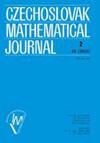平面有向图的大多数选择
IF 0.5
4区 数学
Q4 MATHEMATICS
引用次数: 0
摘要
具有k种颜色的有向图D的多数着色是赋值π:V(D)→ {1,2,…,k},使得对于每个v∈v(D),我们对于至多一半的所有外邻居w∈N+(v)具有π(w)=π(v)。有向图D是多数k-可选择的,如果对于大小为k的颜色列表到顶点的任何赋值,这些列表中有D的多数着色。我们证明了如果U(D)是一个没有4-环的1-平面图,那么D是多数3-可选择的。我们还证明了每一个NIC平面有向图都是多数3-可选择的。本文章由计算机程序翻译,如有差异,请以英文原文为准。
Majority choosability of 1-planar digraph
A majority coloring of a digraph D with k colors is an assignment π: V(D) → {1, 2, …, k} such that for every v ∈ V(D) we have π(w) = π(v) for at most half of all out-neighbors w ∈ N+(v). A digraph D is majority k-choosable if for any assignment of lists of colors of size k to the vertices, there is a majority coloring of D from these lists. We prove that if U(D) is a 1-planar graph without a 4-cycle, then D is majority 3-choosable. And we also prove that every NIC-planar digraph is majority 3-choosable.
求助全文
通过发布文献求助,成功后即可免费获取论文全文。
去求助
来源期刊
CiteScore
0.90
自引率
0.00%
发文量
0
审稿时长
6-12 weeks
期刊介绍:
Czechoslovak Mathematical Journal publishes original research papers of high scientific quality in mathematics.

 求助内容:
求助内容: 应助结果提醒方式:
应助结果提醒方式:


